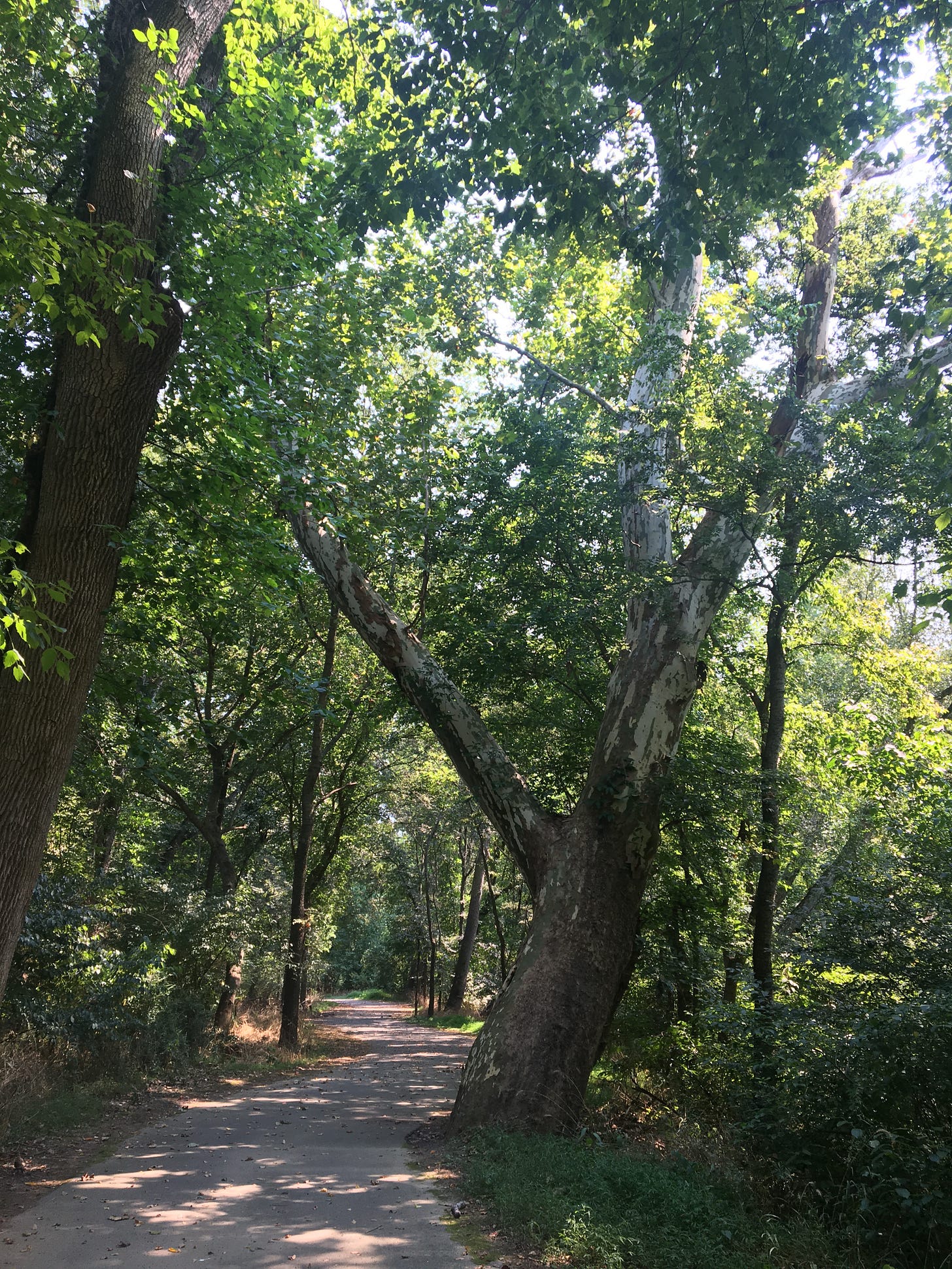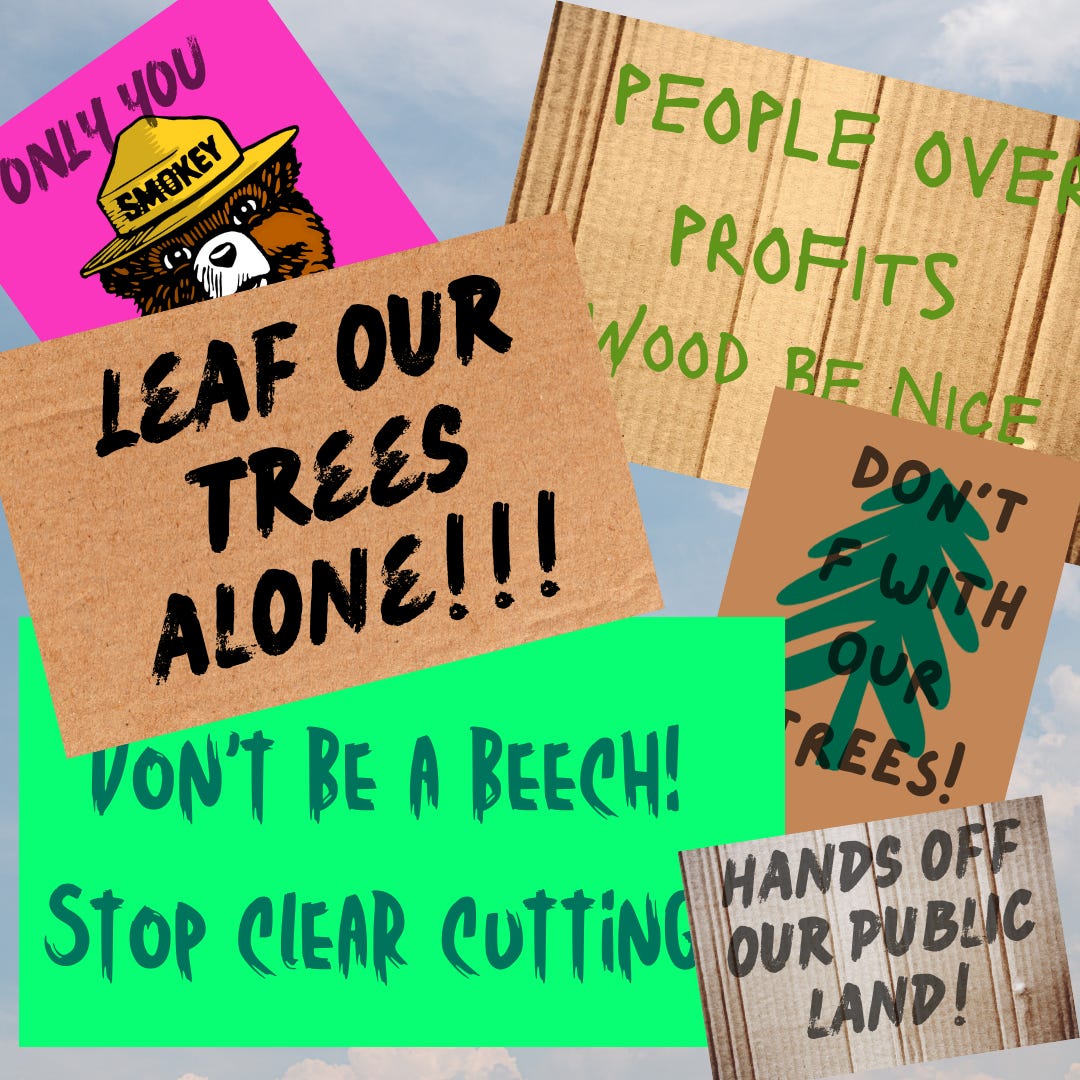Keep Your Grubby Hands Off Our Trees
Why we're justifiably pissed off about Trump's new forest policy
It’s not just national parks that Donald is actively destroying, our large swaths of connected greenspaces and national forests are also very acutely under his attack. This month’s executive order to open up national forests for deregulated private timber harvesting is reckless beyond words. It is also a slap in the face to the thousands of citizens who were protesting his national land policies, as he callously signed the new policy into effect.
But let’s take a beat. As we protest this action (and we must protest it loudly), we need to balance our emotional response with fact-forward challenges. As someone who has made a habit of advocating for more, not fewer trees in public places, I can confidently say that the most effective arguments come in numeric form, no matter the validity or superiority of other rationale.
In rough numbers, what we’re giving up:
Even though it is a bit of an insult to reduce the value of a tree into economically quantifiable terms, it isn’t hard to do. Trees’ ecological benefits can be put into black-and-white, bottom-line terms that others use to validate cutting them down. And our fine-foliaged friends can easily come out on top.
It’s actually not a stretch at all, because many of their benefits like stormwater drainage, air purification, heat reduction, habitat preservation, soil quality, and quality of life have quantifiable aspects to them. We could do a series of posts, each dedicated to one of these functions, and still not do justice to the complete value of trees in our cities, towns, parks, and forests.
Depending on the size, location, and type of tree, each may reliably provide a hundred dollars of benefits per year in carbon sequestration and stormwater drainage. This does not include many of the less measurable but very real benefits mentioned above that all have financial implications. When compared with a one time profit of around 150 dollars for a mature tree in lumber prices, the benefit is clear.
I hate arguing for trees in purely economic terms, but right now, it’s the world we live in. Trump world only sees dollar signs.
In clear logic, how we’re putting ourselves at risk:
Blind capitalists love to value short term gain over long term benefits, so let’s add in a few more really salient points about immediate cost-invoking threats that Donald’s clear cutting idea imposes.
Fire damage from forest fires costs the US between 394 and 893 billion dollars a year. As we take away and ignore many of the wildfire prevention methods, that cost is likely to increase. Experts warn that this administration’s clear cutting and forestry personnel reduction will result in more devastating loss starting this summer.
Food insecurity increases with clear cutting because of a few reasons. Soil that was held together and nourished by tree roots cannot sustain itself. It will wash away and all of the VIP microorganisms it holds will be lost. At the same time, pollinators that our food systems depend upon lose their habitats. With all of this activity, invasive species have an inviting environment to take over, threatening the plant and animal species that we rely on for food. None of this can be rebuilt within any of our lifetimes, and any attempts to undo damage are astronomically expensive.
Federal job losses of foresters affect individual, community, and national economies. The cost of cutting those also outweighs the fleeting and flimsy benefits.
We’re reasonable people here…
So in most cases, the fight to keep trees right where they are is well worth it. But as with everything, moderation is key.
I remember my first time learning that the parks department I work for was cutting down trees on our properties, because it was sad. I had been in the habit of advocating for trees, making the case that the cost of downing them far outweighs any potential short term benefit. But I soon learned how essential it was to monitor our trees, evaluate their location and health, and plan for their removal and replacement.
All trees have a lifespan, and people have needs and safety concerns that must be looked after. One of our state partners who were avid advocates for the environment often said that they were not against development—it just needs to be in an appropriate location and include special mitigation.
Many times, like the one we’re in now, this is not what is happening.
This reminds me of a morning I started the day with a surprising message that a large swath of old-growth trees in one of our largest and most canopy-rich urban parks had been clear cut. Our whole department felt the burn. When we spoke to the public works department who ordered the clearing, they had been planning this for years as an insurance that tree roots wouldn’t damage the water system that ran through the park. We weren’t included.
If we were, we would have wanted a more holistic plan, including resources to plant replacement trees elsewhere. We would have insisted that our department receive payment for the lumbar harvested, rather than its profits being indiscriminately given away to the service providers. And we would make sure that in the treeless area, we created an environment that was still safe and inviting for our park goers and healthy for the park ecosystem.
Right now, the US Forestry Department is not benefitting—private extractive lumbar businesses are. Those big corporations who are in line for Trump tax cuts. It’s an absolutely corrupt and ridiculously irresponsible deal.
And we’re reasonably pissed off.
March 21st is International Day of Forests at the United Nations. They are holding a celebration at their headquarters in New York. I look forward to seeing vocal supporters of our public greenspaces, and I hope it helps mount pressure on our decision makers to save them.
Contact your local and national lawmakers, and let them know what this issue means to you. Don’t let this travesty slide under the radar. Share your outrage and spread the word. Our world depends on it.
With love and hope for the future,
Stephanie
I’m keeping my ears open for protests and other pressure points to reverse this action. Let us know if you hear of anything going on and of progress happening in your neck of the woods.
Trump’s executive order and who is benefitting:
https://www.theguardian.com/us-news/2025/mar/03/trump-national-forest-executive-order
For more on valuing trees:
https://www.sciencedirect.com/science/article/abs/pii/S161886671730523X
https://pmc.ncbi.nlm.nih.gov/articles/PMC7970529/
https://www.sciencedirect.com/science/article/abs/pii/S161886671730523X
https://mytree.itreetools.org/#/report/individual?era=forecast&type=benefits
Tree removal risks:
UN International Day of Forests:
https://www.un.org/esa/forests/news/2025/03/international-day-of-forests/index.html




It is absolutely insane what they want to do. Hopefully some lawsuits will put a hold before they start raping the national forests!. I am certain there are going to be lawsuits to try and stop the insanity.
https://en.wikipedia.org/wiki/Tillamook_Burn
We cannot revisit this misery